Stop guessing who your users are — start knowing with segmentation.
It is crucial to understand the target audience and be able to describe the consumer’s profile to ensure a product’s success in the market. Audience segmentation helps marketers have a better understanding of customers and their needs.
Table of Contents
A detailed audience breakdown by various factors can indicate the needs of particular user groups. It will assist marketers in creating messages that best convey the product’s value and convert a user into a customer. A win-win situation for the client and the product developer.
In this article, we will examine various factors that allow detailed segmentation of the target audience for mobile apps and how to use this in ASO.
Demography: An important element when segmenting for ASO
Age group is a crucial demographic characteristic when it comes to targeting the right audience, particularly for children’s apps. Segmenting the audience by age ensures that your content and functionality are appropriate and engaging for the intended users.
For instance, the chart below shows the 2023 statistics on the most downloaded learning apps for children in the United States, across iOS and Android platforms.
Such data helps in understanding which apps are most popular among different age groups and could help you get insights on how to adapt your strategies accordingly.
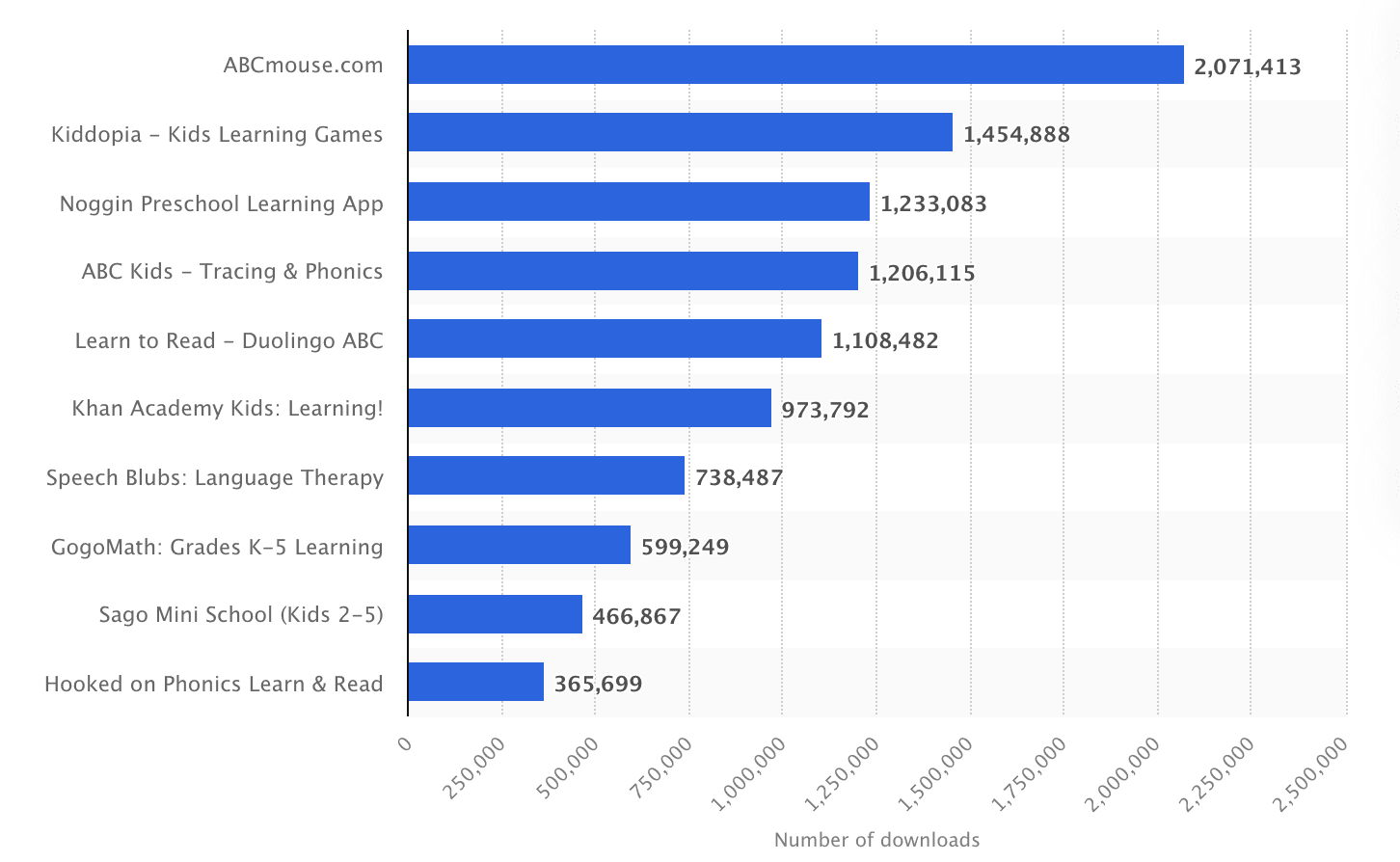
Source – Statista
The audience for children’s apps can be divided into two groups:
- For kids, who are the end users, the app’s page should be visually appealing to capture their attention. This includes using bright colors and featuring colorful characters in screenshots, as well as creating engaging and exciting promotional videos. These elements should be designed to attract and retain the interest of children, making the app more appealing for them to use.
- On the other hand, parents are the actual customers making the purchase decisions. Their choices are often influenced by recommendations from educators, caregivers, child psychologists, and other parents, as well as the app’s visibility on top charts.
From my experience, it’s key that assets for this group reflect social proof, such as reviews from other parents or endorsements from educational institutions or research bodies. This reassures parents of the app’s value and educational quality, helping them feel confident in their choice.
A great example that showcases the visuals targeting both children and their parents is from PBS KIDS Games app page screenshots:
- For kids: The use of bright colors and “cute” characters.
- For parents: Highlighting that games are educational, not only entertaining but also games available offline, that a kid can enjoy on a plane or a road trip.

Source – Appstore
Another example is the app Epic – Kids’ Books & Reading. They’ve done a great job in highlighting the social proof, in the two first screenshots, which ultimately helps in building authority and credibility.

Source – Appstore
Age: An important element in segmenting your audience for ASO
Age is one of the demographic characteristics that can be used for audience segmentation. You can also split the audience by gender, to narrow and specify your communication further.
If we use Health and Fitness apps as an example, we can use the analytics to determine which user groups are more interested in specific workouts. This can help to create more effective marketing campaigns by targeting smaller audience niches through advertising and custom product pages. By doing so, they can convey the same message at each stage of the user funnel.
When ads present an app as a workout planner, but the app’s page instead highlights features like stretching and muscle relaxation without mentioning workout planning, it can be confusing. Users receive mixed messages at different stages, which may leave them puzzled and unsure.
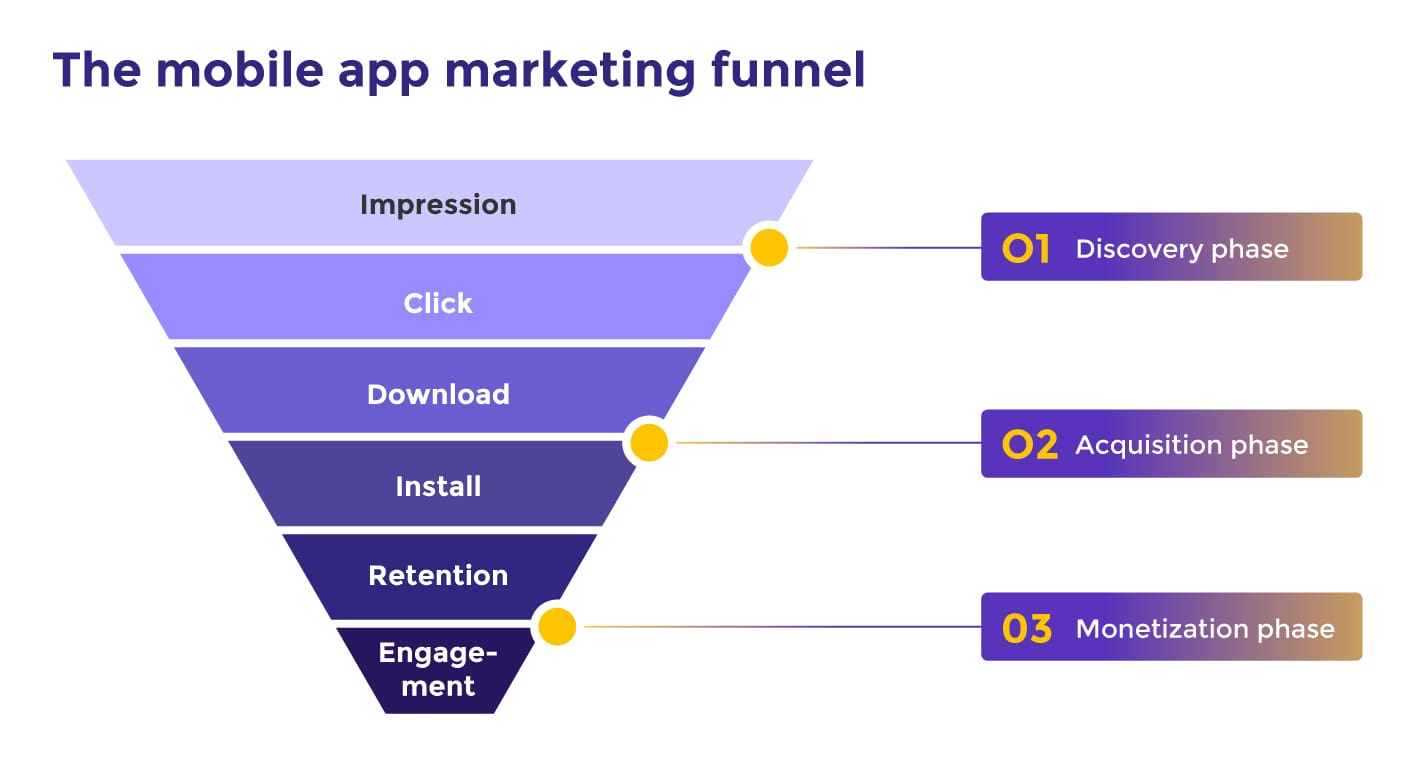 Mobile app marketing funnel by Adjust
Mobile app marketing funnel by Adjust
Also, by analyzing the audience, you can decide to focus on one segment and take a top position there, directing all marketing efforts toward it.
Consider two apps by the same developer: “Lose Weight at Home in 30 Days” and “Gym Workout Planner & Gym Log.” The names of these apps don’t specify that one is exclusively for women and the other for men. However, a closer look at the visual elements on each app’s page might reveal this distinction.
Lose Weight at Home in 30 Days:

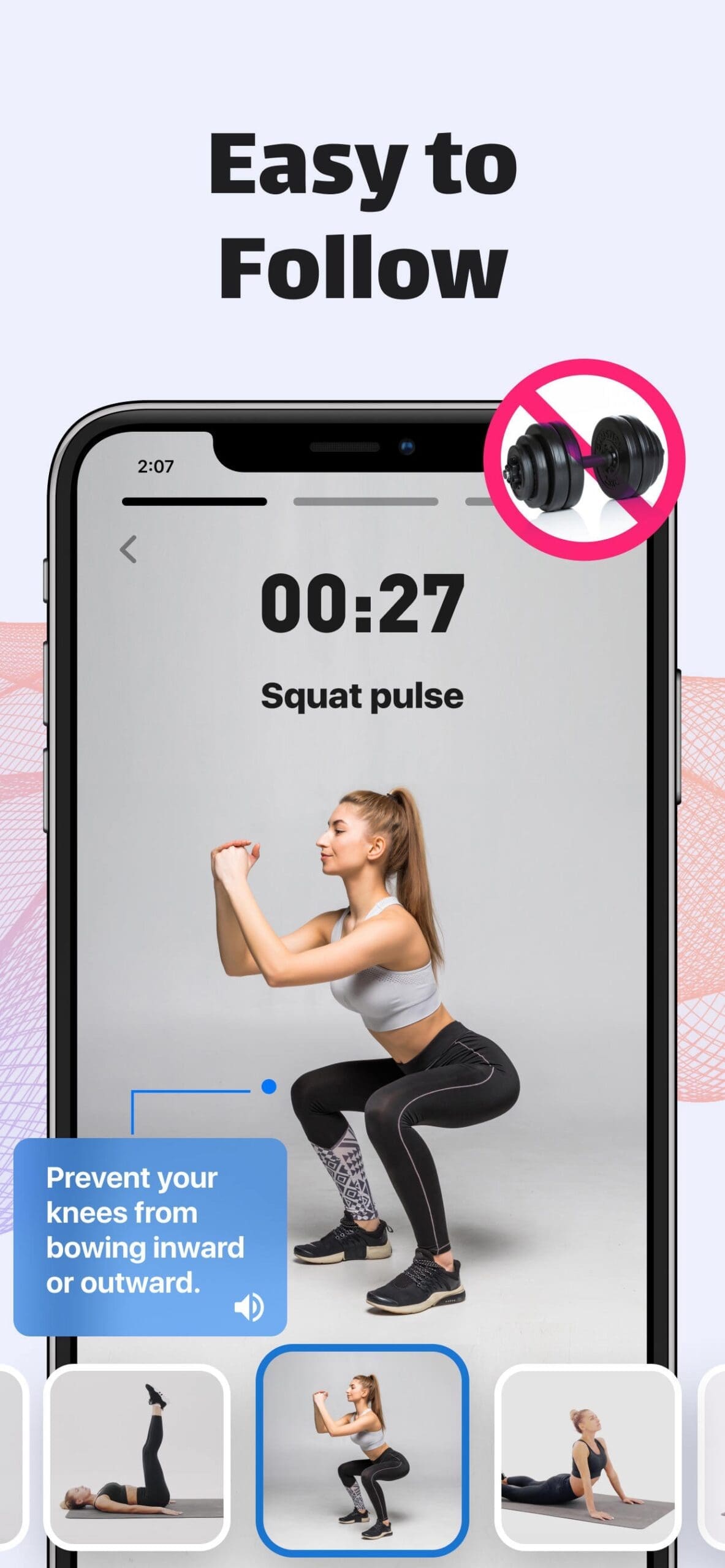


The icon for the home weight loss app features a female figure. While the first screenshot includes both a man and a woman, the second, third, and fifth screenshots predominantly showcase women. This suggests that the app is primarily targeted at a female audience.
Gym Workout Planner & Gym Log:
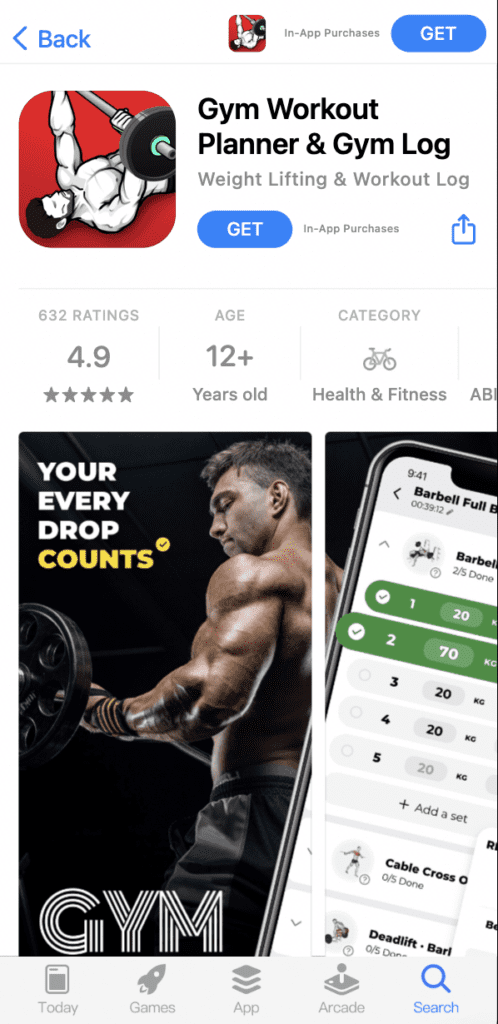



The icon and the first screenshot of the gym app display a male figure. Additionally, in the subsequent screenshots, a male figure appears more frequently than a female one. This indicates that the app is mainly intended for a male audience.
Localization: Think global, act local:
When segmenting by geographical features, it’s useful to consider the country and the language spoken there. This is particularly important if your target market spans countries with multiple languages, such as the United States, Canada, and Switzerland. Additionally, the platform where you’re promoting your app plays a crucial role, as the strategy for optimizing text will vary depending on the platform.
| App Store | Google Play | |
| Number of languages in app console | 40 | 87 |
| Cross-locales* | Yes. Check the link with App Store official reference.
However, this reference was not updated after the big iOS algorithm update in December 2023. |
Google might be able to translate the text on an app’s page using Google Translate, even if that language hasn’t been officially added to the app console. However, if you’re targeting a specific language audience on Google Play, it’s recommended to add that language and handle the text localization yourself for better accuracy and cultural relevance. |
*Cross-locales are languages in the app console indexed in at least 2 countries. For example, English-UK in iOS is indexed almost worldwide according to App Store guidelines.
Segmenting for ASO: Remember Devices
Another key aspect of ASO audience segmentation is the type of device used. The graph below shows the distribution of traffic among mobile, desktop, and tablet users. Even though tablet traffic represents a smaller portion of the total, it’s important to consider these users as well, particularly if the app you’re promoting has a notable share of tablet users compared to mobile users.
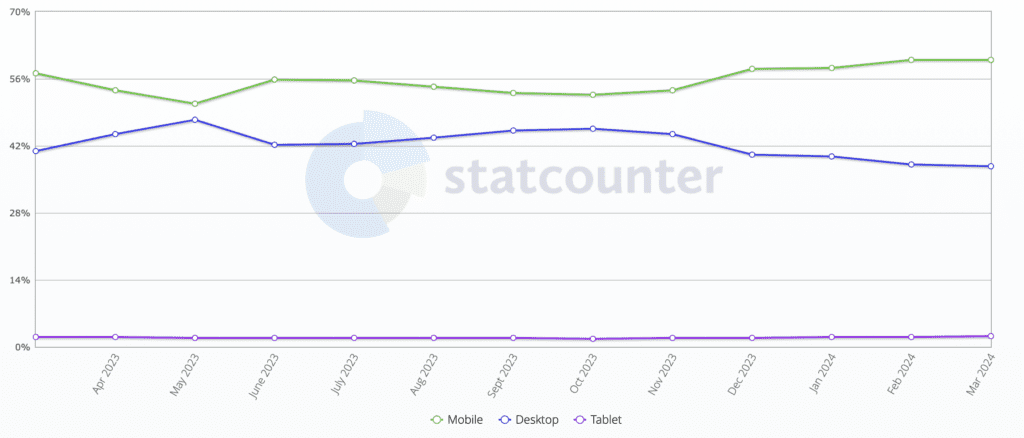
Desktop vs Mobile vs Tablet Market Share Worldwide Mar 2023 – Mar 2024. Source – Statcounter.
Let’s examine the App Store charts broken down by device and compare which apps are at the top.
iPhone, USA, all categories:
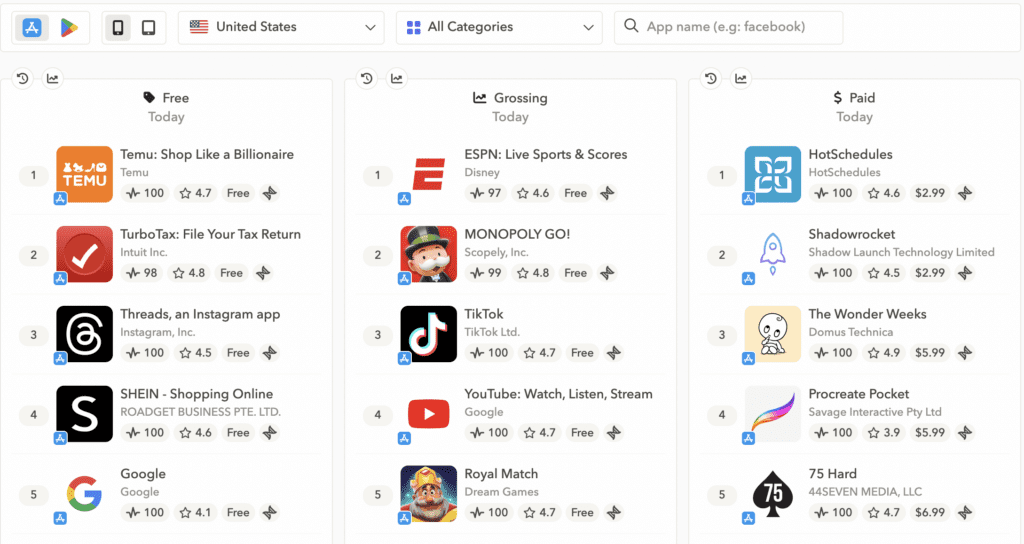
Source – Apptweak
iPad, USA, all categories
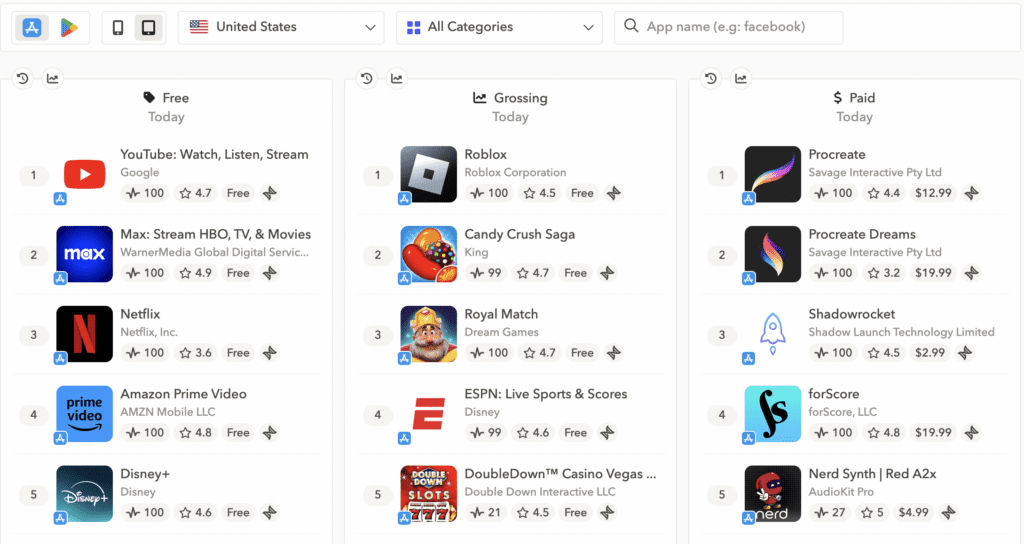
Source – Apptweak
After reviewing the top 5 apps from the Top Free, Grossing, and Paid charts, we can identify certain patterns.
The leading phone apps tend to be social networks, shopping apps, and various games, while top tablet apps are more likely to include games, several streaming platforms, and a sketching app. Some apps, well-optimized for both phones and tablets, often appear in the top charts for both devices.
However, when segmenting your audience by device, it’s crucial to consider how users interact with the app and its features. For instance, sketching is more comfortable on an iPad than on an iPhone, and watching movies may be more enjoyable on the larger screen of an iPad.
Additionally, it’s important to keep an eye on your competitors, especially how they are positioning themselves across different devices. They could potentially outrank you in keyword positions on the App Store for specific devices.
Features (a key when doing ASO Segmentation)
We’re assembling a semantic core to kickstart efforts to boost the app’s visibility. The semantic core is essentially a collection of keywords that are relevant to a specific app, which will be utilized to promote the app in the mobile store.
One valuable source for these keywords is the app’s features. If the app has a variety of functions, the keywords in the semantic core can be categorized into sub-niches.
Below is a table displaying portions of semantic cores for apps in the women’s health, planning, and fitness categories. Each of these apps is indexed for all the keywords mentioned in their respective lists.
| Keywords for Women health app | Volume | Keywords for Planner app | Volume | Keywords for Fitness app | Volume |
| period tracker | 65 | calendar | 66 | calorie counter | 63 |
| ovulation tracker | 47 | to do list | 56 | fitness | 61 |
| cycle tracker | 43 | planner | 56 | calorie tracker | 59 |
| fertility tracker | 39 | schedule planner | 54 | workout planner | 54 |
| pill reminder | 37 | daily planner | 46 | fasting tracker | 48 |
| sex tracker | 29 | schedule | 42 | workout app free | 45 |
| birth control reminder | 26 | agenda | 40 | free workout apps | 44 |
| birth control | 25 | organizer | 36 | nutrition tracker | 43 |
| cycle tracking | 24 | organization | 30 | fitness tracker | 41 |
| track pregnancy | 23 | daily routine | 30 | health tracker | 36 |
| ovulation | 22 | timeline | 30 | fitness free | 23 |
| ovulation calculator | 11 | daily calendar | 20 | healthy eating | 21 |
Source – Apptweak, USA, Volume is Search Ads popularity for April 15th, 2024
From the examples provided, it’s clear how sub-niches emerge within each app category based on their semantic cores:
- For the women’s health app, the sub-niches include pregnancy, period tracking, and birth control.
- For the planner app, relevant sub-niches are calendar, to-do list, planning, and schedule.
- For the fitness app, sub-niches include a calorie counter, fasting tracker, workout, and health tracker.
Exploring these sub-niches further reveals that each one has its own set of competitors. Some competitors might focus exclusively on a narrow niche, while others offer broader functionalities. In this scenario, leveraging custom product pages can be highly effective.
Custom product pages enable you to tailor your presentation to different segments of your target audience, optimizing your marketing strategies to better address specific needs and preferences. This tailored approach can significantly enhance your app’s appeal and effectiveness in attracting and retaining users.
Below is an example of what a custom page might look like. And we described in more detail how to work with them in another article – How to Make the Most of Apple’s Custom Product Pages.
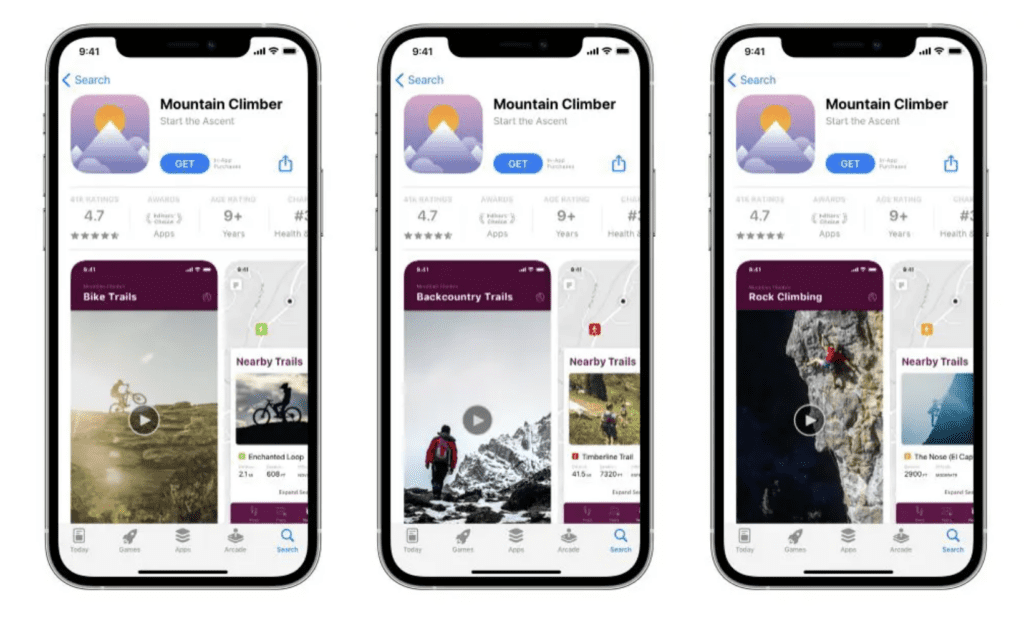
An example of how an app for hikers, climbers and bike riders uses CPPs
Segmentation for ASO in a nutshell
Audience segmentation is integral to a successful ASO strategy. By analyzing audiences and considering various factors such as demographic, geographic, technical, and functional, you can fine-tune your strategic approach to resonate with specific user groups, maximizing visibility, conversions, and revenue.





